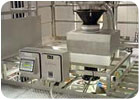
Burke Corporation, a leading manufacturer of fully cooked meat products that include pizza toppings, meatballs and taco fillings, produces high-quality, consistent, and safe products that are made to its customers' specifications. The company's commitment to the customer is reflected in the motto, "Always make it your best."
Although Burke's food safety programs meet or exceed government and industry standards, the processor seeks continuous improvement and constantly raises the bar to enhance food safety. Burke continually monitors sources that may introduce metal particles into the production process. One source, the raw meat ingredients used to produce cooked meat products, may contain small pieces of metal that are undetected during the raw blending process. Another potential source is the contact friction and vibration of metal processing equipment, which may shed fine particles or cause metal parts to be displaced into the product flow.
In the rare instances that metal is detected in finished product, Burke uses a program developed in partnership with the Iowa State University Metals Department to identify and analyze the composition of the particles and determine their source. In order to promptly remedy problems that are traced back to equipment, the company keeps the elemental composition of key machines in its production line on file. While most metals found are stainless steel and low alloy steel, occasionally metals with aluminum and copper are detected.
"Our latest plant expansion provided us with an opportunity to implement our philosophy of continuous improvement and even further raise the bar to enhance our metal particle detection and elimination process," says Jim Chittenden, process and quality control manager. Prior to its recent expansion, Burke's incoming raw meat metal detection was capable of finding particles as small as 5.0 mm. While this was acceptable by industry standards, Burke's new system makes use of a smaller aperture for screening raw meats that can find particles as small as 2.4 mm. With more sensitive detection prior to its grinding operation, the processor has been able to more effectively partner with its vendors to reduce metal in incoming raw materials. "We've also added new metal detection equipment on our two production lines that enables us to find particles as small as 1.0 mm, compared to 1.50 to 2.0 mm with our old system," says Chittenden.
For this expansion project, Burke's list of objectives included improving its metal detection capabilities on both the raw and cooked sides of its operation. Having used Safeline detection systems for many years, Burke has been satisfied with the performance of its units.
The plant faced several challenges in upgrading its system to be effective and efficient as possible. "We worked closely with Safeline's engineering group to develop a system that would achieve excellent metal detection sensitivity levels," says Chittenden, "while at the same time maximizing productivity levels."
Burke operates under USDA inspection and ensures food safety with HACCP plans. Any metal detected in the system is collected and a nonconformance process is initiated to determine the source, followed by an action plan for improvement, such as vendor nonconformance reporting or equipment repair. All information is logged into a database as a permanent record of the findings.
"With this expansion, we are able to find smaller pieces of metal on both of our production lines, as well as in raw materials," says Chittenden. "Preliminary findings indicate that our products are now being monitored more thoroughly." u
For more information:
Diane Tomlinson, Mettler-Toledo Safeline, Inc., (800) 447-4439 x566, www.metaldetection.com